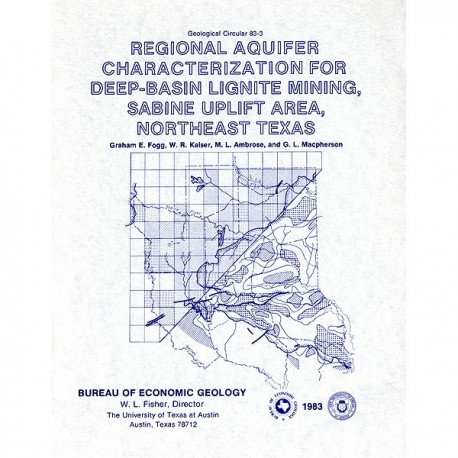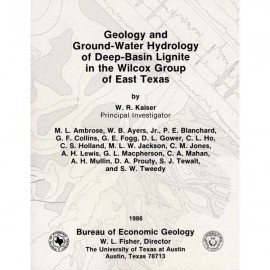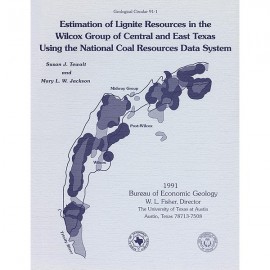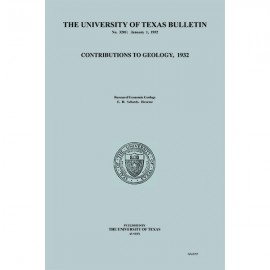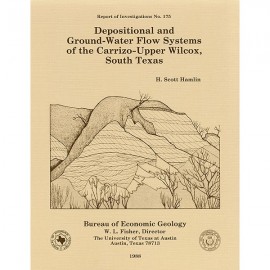Geological Circulars
-
Books & Reports
- Reports of Investigations
- Guidebooks
- Udden Series
- Geological Circulars
- Down To Earth
- Atlases of Major Oil and Gas Reservoirs
- Texas Memorial Museum Publications
- Environmental Geologic Atlas of the Texas Coastal Zone
- Mineral Resource Circulars
- Other Reports
- Seminars and Workshops
- Handbooks
- Submerged Lands of Texas
- Symposia
- Annual Reports
- Open File Reports
-
Maps & Cross Sections
- Thematic Maps
- Miscellaneous Maps, Charts & Sections
- Geologic Atlas of Texas
- STATEMAP Project Maps
- Geologic Quadrangle Maps
- Cross Sections
- Highway Geology Map
- Energy and Mineral Resource Maps
- Shoreline Change and Other Posters
- Wilcox Group, East Texas, Geological / Hydrological Folios
- Bouguer Gravity Atlas of Texas
- River Basin Regional Studies
- Featured Maps
- Posters
- Teachers & the Public
-
Geological Society Publications
- Gulf Coast Association of Geological Societies
- Alabama Geological Society
- Austin Geological Society
- Corpus Christi Geological Society
- Houston Geological Society
- Lafayette Geological Society
- Mississippi Geological Society
- New Orleans Geological Society
- South Texas Geological Society
- GCS SEPM Publications
- Historic BEG & UT Series
Regional Aquifer Characterization for Deep-Basin Lignite Mining, Sabine Uplift Area, Northeast Texas
GC8303
A free, digital version of this publication can be found on: Texas ScholarWorks
GC8303. Regional Aquifer Characterization for Deep-Basin Lignite Mining, Sabine Uplift Area, Northeast Texas, by G. E. Fogg, W. R. Kaiser, M. L. Ambrose, and G. L. Macpherson. 30 p., 11 figs., 1983. Print.
To purchase this publication as a PDF download, please order GC8303D.
ABSTRACT
Lignite deeper than 200 ft (61 m) constitutes about 60 percent of the total lignite resources in Texas. Projections indicate that meeting future demand will require mining this deep-basin lignite. However, because the principal lignite host, the Eocene Wilcox Group, is also a major fresh-water aquifer, deep-basin lignite development by surface mining or underground gasification poses unanswered questions concerning hydrogeologic feasibility and environmental impacts. A regional framework is needed to evaluate these questions and to maximize lignite recovery in a way that minimizes environmental impacts. An integrated geologic/hydrologic analysis delineates characteristics of the Wilcox Group in the Sabine Uplift region of East Texas that are pertinent to (1) feasibility of deep mining and gasification, (2) mine-permit preparation and evaluation, (3) exploration and site selection, and (4) prediction of lignite quality, Subsurface mapping of maximum- and major-sand isoliths shows occurrence and geometry of hydrslsgically significant Wilcox sands that would pose the greatest obstacle to dewatering and depressurization. Three-dimensional mapping of hydraulic head data defines recharge and discharge areas and ground-water circulation patterns. Dewatering and depressurization would be more difficult in major discharge areas than in recharge areas. Vertical hydraulic gradients indicate that ground-water velocities decrease markedly with depth in the Wilcox and that potentiometric surfaces constructed from shallow head data may greatly overestimate magnitudes of the deeper hydraulic gradients. Mapped vertical hydraulic gradients can be used together with local head data to assess vertical interconnectedness of sands and feasibility of mine dewatering by gravity drainage wells. Wilcox ground water evolves along flow path from ca2+-HCO~- to Na+-~C03- water as a result of calcite or feldspar dissolution, or both, and cation exchange on smectitic clays. Mapping of activity indices and saturation indices derived from key reactions helps define regional groundwater circulation patterns and baseline water quality. Empirical relations between borehole resistivity logs and ground-water composition can be used to map further details of Wilcox ground-water quality. High-sodium deep-basin lignites could be attributed to high-sodium ground waters that typify the deep Wilcox sands.
Keywords: lignite, Wilcox Group, hydrogeology, ground water, East Texas, Sabine Uplift, Texas
Citation
Fogg, G. E., Kaiser, W. R., Ambrose, M. L., and Macpherson, G. L., 1983, Regional Aquifer Characterization for Deep-Basin Lignite Mining, Sabine Uplift Area, Northeast Texas: The University of Texas at Austin, Bureau of Economic Geology, Geological Circular 83-3, 30 p.
